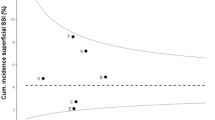Abstract
PURPOSE: The aims of this study were 1) to establish accurate and reproducible baseline surgical site infection rates for our department and 2) to identify risk factors associated with surgical site infection in patients undergoing surgery on a colorectal service. METHODS: Phase I—Surgical site infection grading between the surgeontrainer and the observer-trainee was validated using a four-point scale for wound evaluation previously used by our institution. Phase II—Patients undergoing colorectal surgery were prospectively monitored. The observed surgical site infection rate was compared with morbidity and mortality reports. Patient and perioperative variables were analyzed for their effect on surgical site infection using the chi-squared test. Risk factors approaching significance on univariate analysis (P<0.2) were entered into a multivariate stepwise logistic regression model. RESULTS: Concordance on surgical site infection grading between the surgeon-trainer and the observer-trainee improved from an initial 79 percent to 96 percent during the validation period. The surgeon-trained observer reported a surgical site infection rate of 7.2 percentvs. a morbidity and mortality reported rate of 3.3 percent. Among the variables examined, obesity and surgical procedure category were significantly associated with surgical site infection rates. The effect of prophylactic antibiotics and prior chemotherapy, radiation, or steroid therapy on surgical site infection rates approached significance. A logistic regression analysis incorporating these risk factors for surgical site infection accurately predicted infection status 93 percent of the time. CONCLUSION: Use of a surgeon-trained observer doubles the detection rate of postoperative surgical site infection. Accurate, prospective assessment identifies risk factors significantly associated with increased surgical site infection rates in colorectal surgical patients.
Similar content being viewed by others
References
Emori TG, Gaynes RP. An overview of nosocomial infections, including the role of the microbiology laboratory. Clin Microbiol Rev 1993;6:428–42.
Roy MC, Perl TM. Basic of surgical-site infection surveillance. Infect Control Hosp Epidemiol 1997;18:659–68.
Leape LL, Brennan TA, Laird N,et al. The nature of adverse events in hospitalized patients. Results of the Harvard Medical Practice Study II. N Engl J Med 1991;324:377–84.
Horan TC, Culver DH, Gaynes RP, Jarvis WR, Edwards JR, Reid CR. Nosocomial infections in surgical patients in the United States, January 1986–June 1992. National Nosocomial Infections Surveillance (NNIS) System. Infect Control Hosp Epidemiol 1993;14:73–80.
Olson MM, Lee JT Jr. Continuous, 10-year wound infection surveillance. Results, advantages, and unanswered questions. Arch Surg 1990;125:794–803.
Coit DG, Peters M, Brennan MF. A prospective randomized trial of perioperative cefazolin treatment in axillary and groin dissection. Arch Surg 1991;126:1366–71.
Barber GR, Miransky J, Brown AE,et al. Direct observations of surgical wound infections at a comprehensive cancer center. Arch Surg 1995;130:1042–7.
Poulsen KB, Meyer M. Infection registration underestimates the risk of surgical wound infections. J Hosp Infect 1996;33:207–15.
Lecuona M, Torres-Lana A, Delgado-Rodriguez M, Llorca J, Sierra A. Risk factors for surgical site infections diagnosed after hospital discharge. J Hosp Infect 1998;39:71–4.
Erbaydar S, Akgun A, Eksik A, Erbaydar T, Bilge O, Bulut A. Estimation of increased hospital stay due to nosocomial infections in surgical patients: comparison of matched groups. J Hosp Infect 1995;30:149–54.
Geubbels EL, Mintjes-de Groot AJ, van den Berg JM, de Boer AS. An operating surveillance system of surgicalsite infections in the Netherlands: results of the PREZIES national surveillance network. Preventie van Ziekenhuisinfecties door Surveillance. Infect Control Hosp Epidemiol 2000;21:311–8.
Haley RW. The scientific basis for using surveillance and risk factor data to reduce nosocomial infection rates. J Hosp Infect 1995;30(Suppl):S3–14.
Israelsson LA, Jonsson T. Overweight and healing of midline incisions: the importance of suture technique. Eur J Surg 1997;163:175–80.
Vilar-Compte D, Mohar A, Sandoval S, de la Rosa M, Gordillo P, Volkow P. Surgical site infections at the National Cancer Institute in Mexico: a case-control study. Am J Infect Control 2000;28:14–20.
Forse RA, Karam B, MacLean LD, Christou NV. Antibiotic prophylaxis for surgery in morbidly obese patients. Surgery 1989;106:750–6.
Author information
Authors and Affiliations
Additional information
Read at the meeting of The American Society of Colon and Rectal Surgeons, San Antonio, Texas, May 2 to 7, 1998.
About this article
Cite this article
Miransky, J., Ruo, L., Nicoletta, S. et al. Impact of a surgeon-trained observer on accuracy of colorectal surgical site infection rates. Dis Colon Rectum 44, 1100–1105 (2001). https://doi.org/10.1007/BF02234629
Issue Date:
DOI: https://doi.org/10.1007/BF02234629




